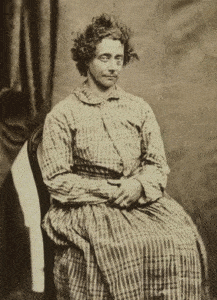
Prior to the 1850’s in New England, insane people, like this woman, were auctioned off to the highest bidder to do with as they pleased.
Sometime around 10:30am on the morning of Saturday, November 12th, 2011, a 24-year-old Danvers, Massachusetts man knocked on his neighbor’s door. When the neighbor opened the door, the man took the cat he was carrying under his arm and tossed it into the neighbor’s house. Startled, the neighbor asked him why he was doing that. The man replied, ““Because of the aliens, they’re in the woods killing people. We need to save the cats.”
The neighbors knew Stephen Ansastasi. He had been in and out of trouble with the police and was known to be a bit peculiar. At this bizarre pronouncement, they thought it best to accompany him home, to have a word with his father and see if he needed help. But when they got to the house, Stephen abruptly announced that his father wouldn’t be answering the door. “The aliens got him,” he said. “He’s dead.”
Indeed he was. 60-year-old John Ansastasi had been bludgeoned repeatedly with a hammer and stabbed twice in the neck. Stephen was the killer. Yet three months later, Stephen Ansastasi continued to maintain his innocence, insisting the aliens had done it.
This macabre turn of events was nothing new for Danvers. Surely if any town could claim to have seen such madness before, it would be Danvers, the creepiest town in America.
Confined in Cages. Naked, Chained and Lashed.
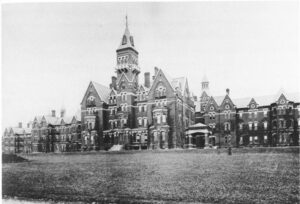
Danvers State Mental Hospital opened in 1878. By the 1940’s it was a hellhole of frenzied violence, blood and filth.
As far back as the 1600’s, Danvers was grappling with the question of what to do with the insane people in their midst. The early solution for Danvers, as it was for other early colonial communities, was to auction them off.
As isolated as these Puritan communities were, clinging to the edge of a strange continent, surrounded by potentially hostile natives and thousands of miles from home, there was no room for gibbering lunatics. But apparently enough of them existed that a policy had to be developed, a policy that said if a sane person wanted to buy the services of a mad person, they could be purchased from the community and become the property of the purchaser to do with as he wished (presumably to work), but if they were not purchased, they would fall back on the community, which invariably led to them being driven out to face the elements and die.
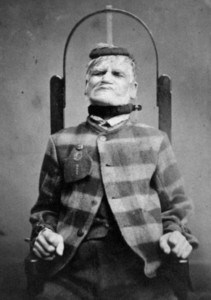
Mental institutions had long been at their wits’ ends trying to control violent psychotic behavior, and then Walter Freeman showed up with a cheap and easy solution.
What is amazing about this system is not that it came into existence, but that it lasted so long. Two hundred years later, in 1841, Massachusetts reformer Dorothea Dix noted that most New England towns still contracted with local individuals to care for people with mental illness. Naturally, such a system was rife with abuse. Dix noted that such individuals were routinely “confined… in cages, stalls, pens! Chained, naked, beaten with rods, and lashed into obedience.” Nothing prevented men from contracting for young women. No one was heartbroken if one of these weird, scary people died suddenly and unexpectedly.
Dix advocated for a more humane system in which state governments would play a direct role in providing homes for the insane. The fruit of her labor in Massachusetts was the eye-popping Danvers State Mental Hospital, a sprawling Victorian era complex consisting of 17 buildings, constructed between 1874 and 1878. In the beginning it was a model of compassionate care and treatment. And then things started to go wrong.
An Ice Pick in the Eye
In 1939 a Portugese psychosurgeon by the name of António Egas Moniz was shot by one of his patients. He spent the rest of his life in a wheelchair. The new procedure he had been developing was the kind of thing that might’ve been expected to provoke violence in a patient. It involved drilling a hole into the skull of the person, and then injecting alcohol to destroy the tissue of the frontal lobe.
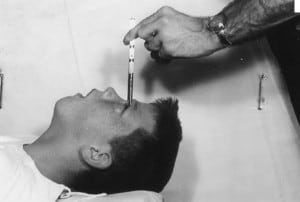
A cure for psychosis? Take a long metal pick, insert it into the corner of the eye and press down to penetrate the brain.
The frontal lobe, it was theorized, was the location of aberrant pathological brain circuits. In an effort to cure psychosis, Moniz sought to attack it where it lived. His efforts had mixed results.
Yet far from being labeled a brutal quack, Moniz was embraced by a frustrated psychiatric community, one desperate for an answer to the riddle of insanity. Among those most impressed was a young American neurologist named Walter Freeman. With Moniz as his mentor, Freeman developed and refined the procedure, giving it a new name; he called it a lobotomy.
Freeman introduced the procedure rapidly in the United States, performing two hundred lobotomies in just six years, almost before anyone noticed. By 1942 he was casting around for a way to speed things up, presumably to get even more lobotomies to his credit. He hit on the approach pioneered by an Italian psychiatrist named Amarro Fiamberti who gained access to his patients’ brains through their eye sockets.
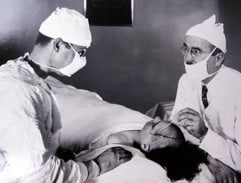
Walter Freeman and James Watts performing a lobotomy. They were a bargain at $25.
It was straightforward. Take a long metal pick, insert it into the corner of each eye, press down and swirl it around, cutting the connections to the pre-frontal lobe in the cerebral cortex. Painful? Undoubtedly. Excruciatingly painful? Why yes. But nothing that couldn’t be overcome with a little electroshock therapy.
Freeman became such a freewheeling purveyor of these so called “ice pick lobotomies” that he actually traveled from asylum to asylum in a van he called “the lobotomobile”. Freeman charged only $25 for each procedure. At some point, it is a foregone conclusion that he pulled up in front of the glowering Victorian hulk that was Danver’s State Mental Hospital and unsheathed his pick.
Welcome to Hell
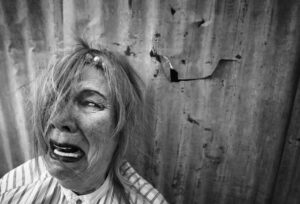
Chronic overcrowding at Danvers led to hellish conditions. In the 1980’s and 90’s they began closing it down.
The howling, shrieks, gurglings and groans emanating from inside the walls of Danvers were enough to make any decent person’s skin crawl. By the 1950’s Danvers was out of control. A hospital that was designed to hold 500 people now held more than 2,000. Frenzied violence occurred in an environment of blood, filth and defecation. Patients far outnumbered staff. Freeman arrived with a solution. It’s a fair guess that Danvers jumped at it. If previous procedures were any indication, patients were restrained, jolted into submission and subjected to ice pick lobotomies.
Some reportedly got better. Many showed no signs of improvement. And others, like Rosemary Kennedy, sister of JFK, reportedly ended up as vegetables.
Still, Freeman rolled on. His partner, James Watts eventually split with him, objecting to the needless cruelty and overuse of the procedure. Indeed, by the 1960’s lobotomies were being given cavalierly, sometimes to teenagers who had acted up in school.
Back at Danvers State Mental Hospital, lobotomized patients wandered the hallways like zombies. Although their violent outbursts may have been curtailed, the generally hellish atmosphere could only be reduced by alleviating the overcrowding. Finally, with the advent of anti-psychotic drugs in the mid-1970’s, Danvers began cutting back on its population. Gradually it began closing down each of its seventeen buildings, and finally, in 1992, closed down altogether.
Danvers by Any Other Name
For the next fifteen years, the eerie old asylum remained empty, abandoned. Stories of strange disembodied voices, wails, and tortured groans were common. The place became a magnet for ghost hunters and adventure seekers. The alleged goings-on there inspired two movies and two novels, included H.P. Lovecraft’s classic, “The Thing on the Doorstep”.
In 2005 the property was bought by Avalon Development and turned into an apartment complex. Most of the buildings were torn down, but the imposing Victorian façade of the main building was retained and incorporated into the new structure. Today, you can still see the fearsome face of the old mental institution as anxious patients saw it, committed against their wills, transported down a dark road to be delivered into this squirming hell.
In Danvers they don’t like to traffic in superstition and ghost stories. They like to think of themselves as a normal suburban New England town, and to most outward appearances, they are just that. But Danvers can’t escape its dark past, and in some cases they might do well to heed it.
In 1875 when they were looking for a site to build Danvers State Mental Hospital, they might’ve been well advised to choose another spot. The site they located it on already had a dark history. It had been the homestead of John Hathorne, one of the harshest judges at the Salem witch trials. Many of the scenes of that grim undertaking occurred on the same spot, and in the surrounding vicinity. In fact, the town of Danvers once went by another name. It was called Salem Village, the actual site of the Salem witch trials.
The Devil in Danvers
Twelve miles down the road in the adjacent town of Salem they have made a business out of marketing the witch trials. Here you’ll find the Salem Witch Museum and costume shops, guided tours, street performers, and all the usual hokum associated with the sanitized version of that horrible event. But only a few of the incidents actually occurred here.
Most of what happened occurred in the isolated and rural community of Salem Village, which, in 1692, was a distant outpost separated from the main town by twelve miles of wilderness. It was a tense and creepy place even before they started hanging people.
The inhabitants of Salem Village were a disagreeable lot. They quarreled over everything: property lines, grazing rights, who or who should not be minister. A long running feud between two local families divided the town. Backbiting and physical altercations were common. About the only thing everyone agreed on was a bleak puritanical theology that attributed every misfortune to the devil.
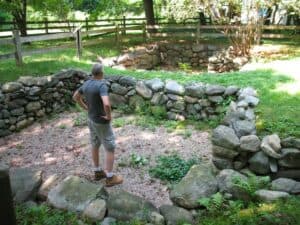
Here I am, standing in the excavated foundation of the Salem Village parsonage. This is the very place where the young women of Salem first started showing signs of being bewitched.
When Samuel Parris arrived to take over the duties of minister, he found himself having to pick sides. Right away, half the parishioners in town shunned his church, largely because the other half was attending. After briefly trying to cajole the standoffish ones, he settled on trying to coerce them by accusing them of iniquitous behavior. This only served to further divide the town. Then things took a bizarre turn.
Nine-year-old Betty Parris, daughter of the minister, and eleven-year-old Abigail Williams, his niece, began acting strangely. They jittered and jerked, they screamed, they crawled around on the floor, and contorted themselves into grotesque positions. Danvers was being visited by its first bout of madness. The authorities quickly determined that the girls had fallen under the influence of witchcraft and set about to find the culprits.
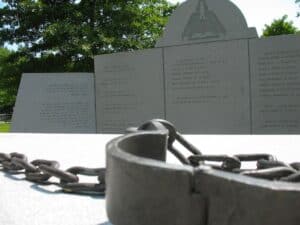
The Salem Witch Trials Memorial in Danvers seeks to make amends for the cruel behavior of its citizens 300 years ago.
The foundations of Parris’s parsonage where these events took place still exist in Danvers. You can find them by walking down a narrow pathway between two suburban homes into a small area hemmed round by harmless looking backyards featuring swing sets and vegetable gardens. It’s hard to imagine that this was ground zero for the hysteria of the witch hunts.
A Dark American Legacy
First to be hauled before the magistrates was Sarah Good, a homeless beggar, who, according to some accounts, had insulted Minister Parris. Next to be accused was Sarah Osborne, a casual free thinker who rarely attended Parris’s church. Finally, Parris’s own servant woman, a West Indian slave named Tituba, was accused.
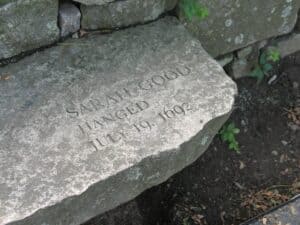
Sarah Good was the first person arrested for witchcraft in Salem. She was a homeless beggar who had insulted minister Parris. She paid with her life.
When these individuals were jailed with little outcry from the community, other youngsters began to show signs of being afflicted and new accusations started to fly. Some of the accused confessed and named accomplices. By May of 1692, the magistrates had 62 people in jail awaiting trial.
One of those magistrates was a harsh and unforgiving man convinced that the accused were guilty. He was John Hathorne, a wealthy merchant and landowner whose homestead would someday become the grounds of Danvers State Mental Hospital. The trials themselves were farcical. The spellbound claimed to be able to see visions of their tormentors and pointed them out in court. The magistrates called on the accused to come forward and touch the victims. If the victims stopped having fits, then the accused were deemed guilty as charged. Dozens of people were condemned on this flimsy evidence.
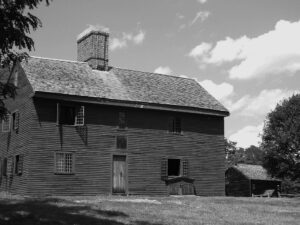
The home of Rebecca Nurse, a 71-year-old grandmother who was hung as a witch, still stands in Danvers. Her hanging sparked a backlash against the hysteria.
It appears that Bridget Bishop was the sort of world-weary, wisecracking barmaid we all know, but in Salem in 1692 her vocation was frowned upon. The fact that she had been married three times didn’t help. Her proclivity for wearing provocative clothing, playing recreational games and making herself memorable to her neighbors also worked against her. So when she scornfully rejected the accusations of witchcraft against her, the authorities took it as a sign of her guilt. She was hauled before the magistrates, condemned and executed. She was the first victim of the trials. Thirteen more followed.
Today the home of Bridget Bishop still stands in Danvers, as does the home of Rebecca Nurse, a 71-year-old grandmother and well-respected member of the community whose only crime appears to have been a series of acrimonious land disputes with the powerful Putnam family. Indeed, it was the testimony of Ann Putnam that condemned her. She was hanged on July 19, 1692. Her death provoked the first public backlash against the trials.
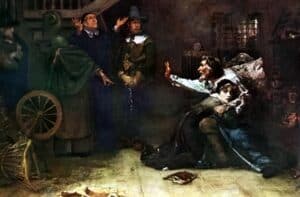
Thirteen people were hanged as witches in Salem Village, a town that eventually changed its name to Danvers to escape the shame of what it had done.
The final witch trial was held in May of 1693. Thereafter, public condemnation of the trials grew. Eighteen years later in 1711 a petition was accepted reversing the charges of witchcraft against 22 of the victims. A hundred years later, the goings-on at Salem were universally condemned as a shame and an outrage. Even so, it was not enough to prevent it from happening again. The New York Draft Riots, the Red Scare of 1919, and Joseph McCarthy all owe a debt to Danvers and its legacy of hysterical acrimony.
Perhaps there is something unique in the American character that makes us prone to witch hunts of all kinds. Fomenting fear against a vague and amorphous “other” has long been a tactic of demagogues and rabble-rousers. While it’s disappointing that it happens, it’s even more dismaying how often it succeeds. Americans, frightened by the unfamiliar, shocked by the unexpected, fall prey to those who would manipulate them. The results are almost always tragic.

Stephen Ansastasi bludgeoned his father to death with a hammer. Was it really aliens in the woods?
Out of Nowhere
On June 16th, 2011 a mysterious blast rocked Danvers and surrounding communities. It was enough to rattle windows and set furniture to vibrating. No one seemed to know where it came from. Explanations ranging from a construction explosion to rock blasting in a nearby quarry were offered, but didn’t pan out. No smoke or fires were seen. The police were baffled. Five years earlier, a blast at a chemical plant had exploded with the force of a magnitude 0.5 earthquake in Danvers, knocking houses off their foundations and obliterating the plant. This time no damage was reported. The source of the blast remained a mystery. It was weird. Maybe a little creepy.
Five months later Stephen Ansastasi became convinced that aliens were roaming the woods of Danvers, killing people. Before he had time to think things through, he became the thing he feared the most. He bludgeoned his father with a hammer and stabbed him.
Maybe it was the drugs; Stephen was a heroin user. Maybe it was the tension in the home; Stephen and his father “fought constantly” according to neighbors. Maybe it was all this and more. Maybe it was the vague sense of apprehension, the subtle whiff of fear that comes with living in a place like Danvers, where weird, scary things erupt violently out of nowhere, and leave behind an enduring sense of dread.
Danvers State Hospital Retelling
– a video on YouTube
Previous stop on the odyssey: Mt. Washington, NH //
Next stop on the odyssey: Niagara Falls, NY
Sources:
Buccini, Molly and Masterson, Les. Murder Suspect Said ‘Aliens’ Killed Father, According to Neighbors. DanversPatch.com,12 Nov 2011, 30 Sept 2012.
Dorothea Dix quote, Dix, Dorothea L (1843), Memorial to the Legislature of Massachusetts 1843, p. 2, retrieved 1 Oct 2012.
Danvers State Insane Asylum. Danversstateinsaneasylum.com, retrieved 1 Oct 2012.
Walter Jackson Freeman III, Wikipedia, retrieved 1 Oct 2012.
Kincaid, Andrew. Lobotomy – The Ice Pick Cure. Lucid Dreams and Saturn Skies. 20 April 2012. 30 Sept 2012.
Efeyas. Insane Asylums – America’s Most Notorious Hauntings, 12 June 2010. 30 Sept 2012.
Salem Witch Trials, Wikipedia, retrieved 2 Oct 2012.
Burke, Alan. Mystery Blast Baffles Neighbors. The Salem News, 17 June 2011, 2 Oct 2012.
Image credits:
Portrait of an insane Woman, Public Domain; Danvers State Mental Hospital, Public Domain; Henry Clarke image of mental patient in restraint chair 1869, Wellcome Library Iconographic Collection; Ice pick lobotomy, George Washington University Gelman Library; Walter Freeman and James Watts, Miriam Posner; Miserable woman, Scott Griessel; Danvers Mental Hospital interior, Weburbanist; Endicott Family Cemetery; Alexis; Witch hanging, Public Domain; Parsonage site, Malcolm Logan; Salem Witch Trials Memorial, Malcolm Logan; Sarah Good marker, Malcolm Logan; Rebecca Nurse House; Daderot; Accused of Witchcraft by Douglas Volk, Public Domain; Bloody hammer, Skeats; Danver’s State Hospital at night, Public Domain

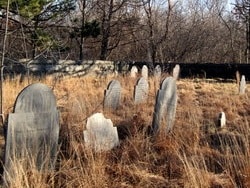
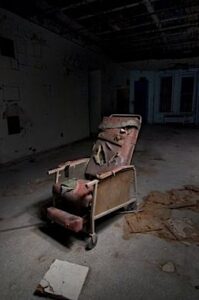
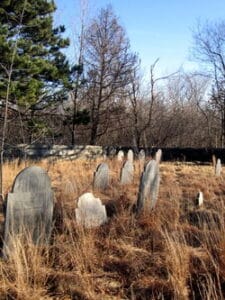
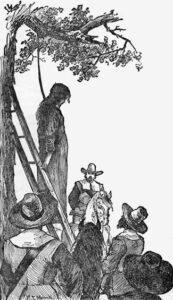
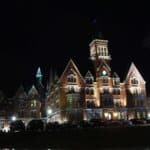
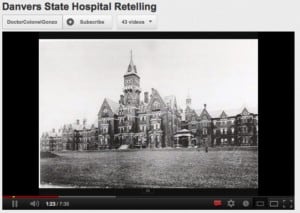
8 comments
Another entertaining story. Hope you got over to Salem during your visit to Mass. Lots of good history to keep you busy for a while.
I grew up in Beverly, the town between Danvers and Salem. I loved the Witch stories growing up. I thought the history was rich, albeit strange. But the behavior during the Witch Trials wasn’t localized to the area, it was rampant everywhere. Salem just took it a little further, and they made history. We look back at the behavior as abhorrent, but really it’s a blessing. A necessity. A rite of passage we needed to make as humanity in order to become as civilized as we are now. Sadly, we seem to be regressing, but that’s another story. My last point is that while I loved the movie Session 9, and all the cool history from this area, this article is a piece of manure. Steaming and stinky, at best. Must be Halloween again. It’s an excuse to have fun, not to make crap up and flood the net with pathetic conjecture. Oh well. If you ever get to come to this area, it’s awesome. Just visit and you’ll see.
This is an interesting article, and you did a great job of describing the history of Danvers. But I am the neighbor of Stephen Anastasi, and the one who found his father’s body. All I wanted to say is that there were absolutely no aliens, and Stephen eventually admitted that himself. The only reason that he was mentally ill was because of drugs and his dark past, and those were the reasons why he did what he did. It was not because he lived in Danvers.
that shit is fucked up and creepy my friend is planning on moving there so good reddens Abby…
I met my husband who grew up in Danvers in orchard village , his street was first street in neighborhood and the rest was cow fields and the cow tunnels … Very quiet Town !!
Aloha from Hawaii,
I grew up in Danvers! In the blizzard of 78 when the highways were closed and we couldn’t make it up north to NH, my family and a whole slew of us all went skiing on the hill where the “nut house” was {DSH}. It is beyond a doubt one of the best memories of my childhood. My father simply tied a rope to the back of the hitch of his 4WD 4 door red Ford truck and we grabbed a hold of that rope for all we were worth and we had ourselves a rope tow for a full day of great skiing. I have memories of seeing ‘patients’ in the windows of the huge victorian building smiling and waving at us. We waved backed while having a ruckus time skiing. No one bothered us. No security had us leave, nothing unusual or creepy happened that day. We just had a grand old time in a blizzard.
Thank you “Dr. Wonderful”, {my father, Dr. Connor}, my beautiful mother Anna, the “Candy Man” aka ‘Wink’ Emerson, the Appels, the Banks, the Essembers – so many wonderful Danvers families.
My mother worked at DSH for a short period in accounting and then my older sister worked there as an LPN and after completing more school she was there as an RN. For certain she had stores about the patients yet she as well as my Mother, loved her patients and shared many joyful as well as sad stories about them and their lives at DSH.
I went onto represent our nation in the IXth Winter Olympic Games in Albertville France and won 2 back to back World Pro Championships in skiing. Creepy! Oddly enough now I work with people in emotional, mental and spiritual training! Creepy!
I left Danvers only because I loved skiing and training was better with more opportunity to hone my skills in more mountainous country. Now I live in Hawaii. When I meet someone from Massachusetts, and especially when old friends visit from Danvers I get a bit excited. I mean how many Red Sox fans do you think live in the Hawaiian Islands?
In short, I am proud to call Danvers home. Someday I hope to return to the sweet little town and the wonderful families that gave me such good memories and such a great start in life! Thank you Danvers. Creepy is the last thing I would call my home town but then again I am not trying to sell people on some idea that Danvers is anything other than a town with a past full of farming, hard working families, schools, and sure it was Salem Village once, but so what? I mean I am fascinated with our history. I am. Yet you all should see some of the places throughout the world where say – the inquisition occurred, or slave trade, or the killing fields, or say Pompeii or Kilauea!?!
History is everywhere and most of it is not so pretty. In fact humans can be pretty brutal. The human race is struggling to evolve to a place where we stop killing one another and where we love and care for one another and peace reigns in our world. Yet that will only happen when peace reigns in our hearts. This article only sensationalized the darker historical references of Danvers past and it does not speak of the light and love I know is in Danvers. I look forward to coming home sometime soon. From the land of aloha, Danvers Rocks!
I live in Danvers and find it a great place to live. Sure, the Asylum (Now Condos, I believe)is a bit Creepy, but All in All, I Love living here.
There has been some Violent Crime, but Danvers as a whole is a Pretty Safe Small Town. I live in the downtown area and have Zero fear walking around the neighborhood. I actually lived on the Page Estate on Page St, where one of Jeremiah Pages grandsons ‘apparently’ tried to rob a bank in the somewhere around 1830 – 1840 (guessing from Age of son, article was vague)and apparently was shot and killed on the property I was renting! About 170 years after this incident… (who knew???)This is a Great Place to live, even though there is a Dark History here.
If you ever come back to Danvers and really want to be creeped out, visit the cemetery with the patients at the old Danvers Asylum. The cemetery is behind a building, past an old tomato field. Most of the graves are unmarked but there are 3 stones in front of a bench that have all of the names of the deceased patients. I have visited there and it was my mistake to go at night. I heard screams and rustling in the forest. One of the trees in the cemetery has scratches on it, I presume from the trapped spirits. As I was leaving up the hill I looked to the clock tower where the surgeries used to be performed and I saw the doctor.